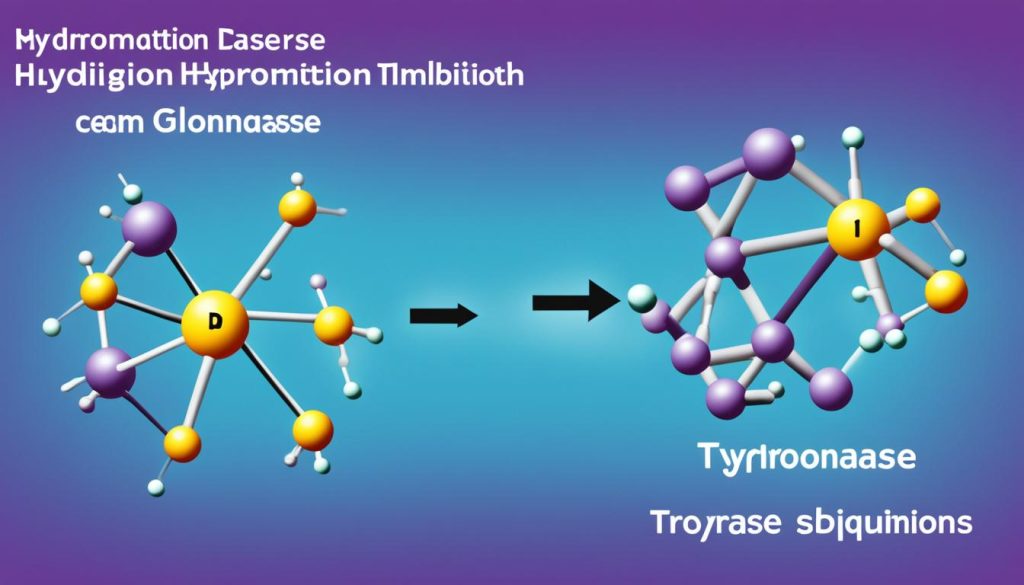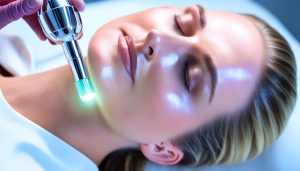Did you know melasma is a big problem for many people? It’s caused by the sun and hormone changes. It’s one of the top causes of dark skin patches that many face1. This condition, where dark spots appear on the skin, really affects how people feel about themselves. There are many types of hyperpigmentation. Age spots, melasma, and scars from acne are common types. There are treatments available. Some are prescribed medicines like hydroquinine and tretinoin. Others are natural options like arbutin and licorice extract.
Choosing the right ingredients is key for treating hyperpigmentation. Dermatologists suggest using niacinamide and vitamin C. These help make the skin brighter and more even12. Hydroquinone is often seen as the best choice for many types of hyperpigmentation. It works on melasma, freckles, dark spots, and scars from acne12. Retinoids, like tretinoin and tazarotene, are praised for reducing dark spots. They make the skin smoother and help with scars and uneven skin tone13.
Glycolic acid is great for dealing with melasma. It gets rid of dead skin cells, helps with dark patches, and makes more collagen123. Tranexamic acid and arbutin are top picks too. Tranexamic acid stops melanocytes from being too active. Arbutin helps control how much melanin is made23. Azelaic acid and kojic acid are also excellent. They brighten the skin and are powerful against hyperpigmentation23. That’s why these ingredients are highly recommended by dermatologists for a bright and even skin tone.
Key Takeaways
- Melasma is a persistent hyperpigmentation type caused by sun exposure and hormonal changes and requires effective treatments1.
- Hydroquinone and tretinoin are gold-standard medications for reducing dark spots and age spots by controlling melanin production12.
- Glycolic acid is excellent for addressing dark patches and stimulating collagen production for improved skin texture123.
- Tranexamic acid and arbutin are effective in inhibiting melanocytes activity and controlling melanin production to treat hyperpigmentation23.
- Azelaic acid and kojic acid offer skin brightening benefits and are effective against various skin pigmentation issues2.
Understanding Hyperpigmentation
Hyperpigmentation makes skin dark with spots or patches in shades like brown, black, or red. It’s a common skin issue that lowers self-esteem and confidence. Causes include sun exposure, acne scars, and hormonal changes from pregnancy or conditions like Addison’s disease45.
What is Hyperpigmentation?
Hyperpigmentation means too much melanin makes areas of the skin dark. It happens due to various reasons. It’s especially common in darker skin tones, which naturally have more melanin4. It’s also linked to serious conditions that affect melanin4.
Common Causes of Hyperpigmentation
The sun’s rays can cause hyperpigmentation by making the skin produce more melanin5. Hormonal changes, like those during pregnancy or from birth control pills, can lead to melasma, a type of hyperpigmentation. It usually goes away after pregnancy or stopping the medication45. Skin injuries, such as from acne or burns, can also cause post-inflammatory hyperpigmentation (PIH), more so in darker skin5.
Different Types of Hyperpigmentation
There are many types of hyperpigmentation, like melasma, which often affects women and those with darker skin due to hormonal changes45. Sun spots, from too much sun, appear typically where skin sees most sunlight. Post-inflammatory hyperpigmentation results from skin issues like acne, leading to dark spots45.
The Importance of Sunscreen
Using sunscreen every day is key to protect against the sun and treat hyperpigmentation. A broad-spectrum sunscreen with SPF 50 or more helps prevent skin damage. It keeps skin healthy, especially when it’s most vulnerable.
How Sunscreen Helps in Managing Hyperpigmentation
Sunscreen is vital for managing hyperpigmentation as it blocks harmful UV rays. These rays can increase melanin, leading to dark spots6. For conditions like melasma, daily sunscreen is essential6. It also prevents more sunspots from forming7.
Choosing the Right Sunscreen for Your Skin
Pick a broad-spectrum sunscreen with SPF 50 to fight UVA and UVB rays best6. Make sure it matches your skin type to avoid irritation and stay consistent. Sunscreens with high SPF offer better protection against dark spots7. A dermatologist can help find the perfect sunscreen for you, ensuring your skin stays healthy.
Niacinamide for Reducing Dark Spots
Niacinamide, a versatile vitamin B3 form, has profound skin benefits. It helps reduce dark spots and repairs the skin barrier. Niacinamide is a formidable ally in your skincare routine, offering various benefits.
Benefits of Niacinamide
Niacinamide is known for improving skin conditions like melasma and acne-related pigmentation. It reduces inflammation, making it great for evening out skin tone while addressing acne. Research shows that niacinamide treatment led to good to excellent improvement in 44% of patients, versus 55% with hydroquinone (HQ)8. Besides, niacinamide had fewer side effects, with only 18% of patients experiencing issues, compared to 29% with HQ8.
How to Use Niacinamide Effectively
Adding niacinamide to your skincare is easy. For example, using products like L’Oréal Paris Bright Reveal 12% Niacinamide + Amino Sulfonic + Ferulic Acid Dark Spot Serum can show results in one to two weeks9. Apply niacinamide serums or creams after cleansing and before moisturizing for the best effects. Research including L* axis colorimetric assessment and infrared light thermography showed no significant difference between niacinamide and HQ treatments after 8 weeks8.
Consistent use of niacinamide helps lessen the appearance of dark spots. Dermatologists often recommend products that mix niacinamide with ingredients like licorice extract and retinol. This approach provides a more comprehensive solution for managing hyperpigmentation9.
Niacinamide notably reduces inflammation and helps repair the skin barrier. It’s effective for achieving an even skin tone and treating melasma. Adding niacinamide to your skincare can give you a brighter, more even complexion. It does this without the harsh side effects of other treatments.
| Treatment | Improvement (%) | Side Effects (%) | MASI Score Reduction | Product Examples |
|---|---|---|---|---|
| Niacinamide | 44%8 | 18%8 | 62%8 | L’Oréal Paris Bright Reveal 12% Niacinamide9 |
| Hydroquinone | 55%8 | 29%8 | 70%8 | Obagi Nu-Derm System |
Vitamin C for Brightening Skin
Vitamin C is known for its strong antioxidant benefits. It’s key in treating skin discoloration. It fights post-inflammatory hyperpigmentation and boosts collagen for glowing skin.
Antioxidant Properties of Vitamin C
Vitamin C has powerful antioxidant properties that fix damaged skin and lessen dark spots. Applying 10% Vitamin C can reduce skin redness by 52% and sunburn by 40-60%.10 It also stops too much melanin, helping with skin discoloration.10
Studies have shown Vitamin C protects cells and prevents skin darkening. This makes the skin look better and healthier.11
Combining Vitamin C with Other Treatments
Adding other treatments with Vitamin C works better. For example, mixing it with 0.5% ferulic acid and 1% Vitamin E makes Vitamin C eight times more effective.10
Using Vitamin C with treatments like iontophoresis shows great results in melasma cases. This shows combining treatments can really enhance what Vitamin C does.11 Vitamin C also makes more collagen, giving a youthful skin.10 Keeping the product’s pH below 3.5 makes sure Vitamin C works well.10

Let’s see the effect of combining Vitamin C with other things on skin hyperpigmentation:
| Combination | Key Benefits | Notes |
|---|---|---|
| Vitamin C (15%) + Ferulic Acid (0.5%) + Vitamin E (1%) | Increases Vitamin C efficacy eight-fold | Helps lessen skin discoloration and boosts antioxidants.10 |
| Vitamin C + Iontophoresis + 5% Magnesium Ascorbyl Phosphate | Treatment of melasma | Backed by clinical trials.11 |
| Vitamin C + Plant Extracts (Licorice Root, Apple Fruit, Turmeric) | Offers anti-inflammatory and germ-fighting properties | Boosts collagen and brightens the skin.12 |
In summary, Vitamin C is excellent for fixing skin discoloration and hyperpigmentation. When combined with other treatments, it offers unmatched results. It provides antioxidants and supports collagen, leading to glowing skin.
Retinoids for Skin Renewal
Retinoids are powerful forms of vitamin A that help the skin renew itself. They tackle skin issues like dark spots by speeding up how fast skin cells renew. This makes old skin peel off and new skin come in, making your skin smoother and more even13
What are Retinoids?
Retinoids, like tretinoin and tazarotene, are famous for fixing skin problems. They’re good at smoothing skin and reducing wrinkles by making more collagen. Research shows they can make dark spots and hyperpigmentation much better14.15
How Retinoids Help with Hyperpigmentation
Tretinoin and other retinoids help by getting rid of dark old cells. This brings in new, lighter skin cells13. They are perfect for surface-level skin darkening. Tretinoin cuts down on dark spots from acne, shaving, or eczema15. Tazarotene is also great for tougher issues like melasma15.
Using Retinoids Safely
Retinoids are strong, so you must be careful to not irritate your skin. Side effects like burning or peeling can make people not want to use them14. Start slowly, especially if you have darker skin, to prevent extra darkening15. Always wear sunscreen of SPF 30 or more to protect against UV rays and stop spots from getting darker15.
Talking to a skin doctor can make sure your plan fits your skin’s needs. Using retinoids like tretinoin and tazarotene carefully can really help your skin look better.
Hydroquinone: The Gold Standard
Hydroquinone has set the high mark for lightening skin marks for more than 50 years. It tackles dark spots, melasma, and uneven skin tone by blocking an enzyme and lessening melanin16. Many find it highly effective, especially with expert advice.
How Hydroquinone Works
Hydroquinone stops the enzyme tyrosinase, which cuts down melanin in the skin16. This action helps greatly with managing pigmentation and reducing dark spots.
When to Use Hydroquinone
Hydroquinone is great for dealing with melasma and dark marks after inflammation17. You can find it in over-the-counter products with up to 2% hydroquinone. But, doctors can prescribe stronger versions, up to 4% or more, for tougher cases16.
Some treatments can have up to 12% to fully block melanin production16. Always talk to a skin doctor to find out the best concentration for you, like with the Obagi Nu-Derm System.

Potential Side Effects
Hydroquinone is usually safe, but some might get irritation or an allergic reaction17. If you notice any discomfort or long-term irritation, it’s best to stop using it and see a doctor17. Though, serious skin issues are quite uncommon16.
Thanks to its effectiveness, hydroquinone remains a top choice for fading dark spots and achieving even skin tone, as part of a careful skincare plan.
Effective Use of Tranexamic Acid
Tranexamic acid is great for fighting dark spots on the skin. It helps control the cells that cause pigmentation, making skin tone more even. It works well when applied directly to the skin or injected, rather than taken by mouth. This is because it has fewer side effects and works better18.
In a careful study, injecting tranexamic acid into the skin was shown to be the best method. It’s cost-effective and has even fewer side effects18.
Benefits of Tranexamic Acid
Tranexamic acid helps control pigmentation by managing melanocytes. It’s effective for many, with studies showing good results in people over 1618. It works equally well for both men and women18.
In regions like Africa, Asia, and South America, pigmentary disorders are more common. Tranexamic acid is particularly effective here, with a focus on post-inflammatory hyperpigmentation18. The preference lies in applying the treatment topically or injecting it. This fits well into daily skin care routines18.
Combining Tranexamic Acid with Other Treatments
Adding tranexamic acid to other skin-brightening ingredients boosts its power. SkinMedica combines it with niacinamide and phenylethyl resorcinol, which work well together19. One study with 40 patients saw major improvements in skin tone, proving combining these treatments is effective19.
Using tranexamic acid with other helpful ingredients from SkinMedica can give even better results. This approach helps even out skin tone efficiently19. Choosing reputable brands means the products are specially designed for skin issues, offering a trustworthy solution for those managing hyperpigmentation.
| Treatment Method | No. of Studies | Application Route | Primary Statistic |
|---|---|---|---|
| Oral TXA | 4 | Oral | Preferred less due to side effects |
| Topical TXA | 2 | Topical | Better tolerated, effective outcomes |
| Intradermal TXA | 2 | Intradermal | Cost-effective, less side effects |
| Combined (oral + topical) | 1 | Oral & Topical | Promising results with some side effects18 |
Very few people who used tranexamic acid saw their dark spots come back. This shows it’s a lasting solution for better skin tone19. Tranexamic acid is a key part of keeping skin looking great without the patches coming back.
The Role of Kojic Acid and Arbutin
Kojic acid and arbutin are key for making skin tone even and treating hyperpigmentation20. They work by slowing down melanin production.
Comparing Kojic Acid and Arbutin
Kojic acid comes from fermenting rice. It’s great for fixing sun damage, melasma, acne scars, and dark spots21. But, it can lose its power easily if not stored right21.
Arbutin, from the bearberry plant, is in many skincare items like creams and lotions. It can be used twice daily21. Alpha-arbutin is a version that doesn’t degrade easily, making it more reliable.
Benefits of Each Ingredient
Both kojic acid and arbutin naturally stop pigment making. This can greatly improve skin issues like melasma and acne marks21. Using them regularly leads to brighter, more uniform skin21.
Research shows deoxyArbutin as a safe way to lighten the skin20. Kojic acid, especially when combined with hydroquinone and glycolic acid, is highly effective for melasma20.
Azelaic Acid: A Multifunctional Solution
Azelaic acid comes from grains and is known for fighting germs and making skin brighter. With a 10% mix, it tackles issues like facial melasma, acne, and dark spots after inflammation22. It’s great at reducing swelling and controlling skin cell growth, making it a top choice for various skin problems22.
The PCA Skin Pigment Gel is one product that uses this acid to fade pigmentation safely during pregnancy. Research in top journals shows it can lighten dark spots and make skin tone more even22. Users have seen smoother skin, fewer breakouts, and less pigmentation with regular use22.
This solution stands out because it’s free from alcohol, silicone, fragrance, and preservatives. It’s also cruelty-free and tested for allergies and toxins22. Certified by CPNP, it passes multiple tests to ensure safety and effectiveness for all skin types. Azelaic acid’s well-rounded features make it safe and effective for many skin issues.
Conclusion
In wrapping up our journey through skin discoloration solutions, we see that protecting from the sun, picking the right ingredients, and following expert advice are crucial. Using broad-spectrum sunscreens is essential for preventing and treating dark spots. Such sunscreens are key, as shown in this study.
Creating a custom skin care plan with a dermatologist’s help can tackle issues like melasma and age spots effectively. A study proved 5% ascorbic acid’s power in fighting melasma, making it a prime choice for personalized care23.
It’s very important to keep in touch with your dermatologist, to ensure your skin care is both safe and effective. They help adjust your treatment as new research comes out, like the findings in this detailed review on melasma23.
To get and keep a clear, glowing skin tone, making well-informed choices and consulting professionals is the best path. With a comprehensive and expert-led strategy, managing uneven skin tone becomes smoother, ensuring a healthier skin for the long haul.
FAQ
What is Hyperpigmentation?
Common Causes of Hyperpigmentation?
Different Types of Hyperpigmentation?
How Sunscreen Helps in Managing Hyperpigmentation?
Choosing the Right Sunscreen for Your Skin?
Benefits of Niacinamide?
How to Use Niacinamide Effectively?
Antioxidant Properties of Vitamin C?
Combining Vitamin C with Other Treatments?
What are Retinoids?
How Retinoids Help with Hyperpigmentation?
Using Retinoids Safely?
How Hydroquinone Works?
When to Use Hydroquinone?
Potential Side Effects of Hydroquinone?
Benefits of Tranexamic Acid?
Combining Tranexamic Acid with Other Treatments?
Comparing Kojic Acid and Arbutin?
Benefits of Each Ingredient?
Source Links
- https://miiskin.com/anti-aging-beauty/best-ingredients-for-hyperpigmentation/
- https://www.lovelyskin.com/blog/p/six-key-ingredients-that-treat-hyperpigmentation-1
- https://www.lorealparis.co.in/beauty-magazine/skin-care-blogs/7-powerful-ingredients-for-hyperpigmentation-treatment
- https://www.medicalnewstoday.com/articles/323808
- https://www.pcaskin.com/blog/understanding-hyperpigmentation
- https://coola.com/blogs/blog/does-sunscreen-help-with-hyperpigmentation
- https://www.cortinahealth.com/blog/hyperpigmentation-and-sunscreen-what-you-need-to-know
- https://www.ncbi.nlm.nih.gov/pmc/articles/PMC3142702/
- https://www.lorealparisusa.com/beauty-magazine/skin-care/skin-care-concerns/niacinamide-and-hyperpigmentation
- https://www.ncbi.nlm.nih.gov/pmc/articles/PMC3673383/
- https://www.ncbi.nlm.nih.gov/pmc/articles/PMC7802860/
- https://hyperskin.com/products/brightening-dark-spot-vitamin-c-serum
- https://ensoulclinic.com/can-retinol-improve-hyperpigmentation/
- https://www.ncbi.nlm.nih.gov/pmc/articles/PMC2699641/
- https://curology.com/blog/does-retinol-help-with-dark-spots-experts-explain/
- https://www.dulyhealthandcare.com/health-topic/hydroquinone-is-it-still-the-gold-standard-for-skin-lightening
- https://www.ncbi.nlm.nih.gov/books/NBK539693/
- https://www.ncbi.nlm.nih.gov/pmc/articles/PMC9805721/
- https://www.ncbi.nlm.nih.gov/pmc/articles/PMC10081479/
- https://www.ncbi.nlm.nih.gov/pmc/articles/PMC3663177/
- https://beminimalist.co/blogs/skin-care/kojic-acid-or-alpha-arbutin-which-is-better-for-pigmentation
- https://skinfunctional.com/product/skin-concern-acne-pigmentation-textural-irregularities-10-azelaic-acid/
- https://www.ncbi.nlm.nih.gov/pmc/articles/PMC9165630/




